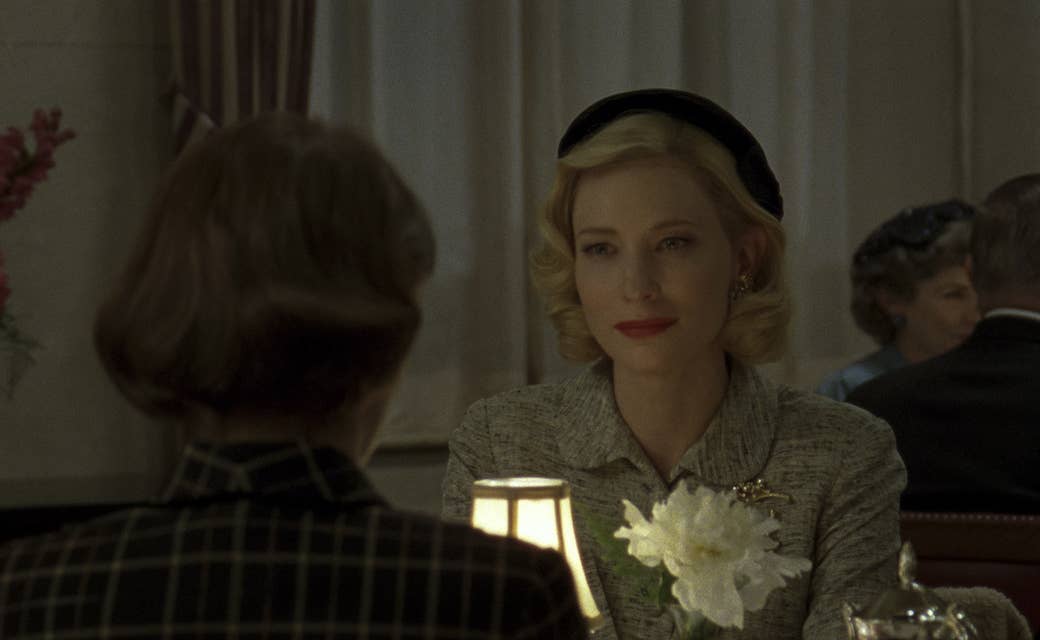
There’s a scene in Carol, Todd Haynes’ sumptuous new lesbian drama, when the film’s heroines finally, at long last, touch. Following many little moments — a squeezed shoulder, a brushed hand — this scene is the long-awaited apogee. Carol Aird, played with usual exquisiteness by Cate Blanchett, is the archetypal Older Woman, on the run from a husband denying her visitation with her daughter; Rooney Mara’s Therese is the Younger, a wide-eyed and short-banged shopgirl aspiring to the photography big leagues. In a cramped hotel room, Carol leans over Therese, who’s splayed before her on the bed, and removes Therese’s clothes. The camera affords us Carol’s eager perspective: We see a swath of Therese’s exposed and lamplit skin. Before leaning down to kiss her, Carol takes a breath. “I never looked like that,” she says.
And — for this viewer, at least — Carol's panted observation momentarily broke the film's spell.
An Older/Younger lesbian storyline can potentially shoehorn both women into mere foils of one another: two distinct symbols of Womanhood at different stages of life, yearning for the trappings of the other’s lifestyle rather than flat-out yearning for the other woman herself. In another gay lady film this awards season, Freeheld, the two main characters also have a significant age difference. While it’s wonderful to see depictions of these kinds of relationships — they’re quite common offscreen, and it’s always a big gulp of fresh air to see any woman over age 40 (gasp!) portrayed as sexy and desirable — the devil’s in the details.
In that dizzying, blissed-out moment of anticipation right before sex, most of us are thinking some version of the same thought: yes, yes, yes. If anything, that’s all the more true if the moment’s been a long, slow time coming. So when Carol’s first spoken thought before enveloping Therese in her arms is “I never looked like that,” it sticks out, seemingly implying that she sees Therese for what she, Carol, no longer is: young, new, untouched by the emotional and physical toll of passing years. Instead of desiring Therese, it’s as if Carol is seeing a lost — but still inferior — version of herself play out against Therese’s body.
It’s just one little line. But it made me consider the ways in which lesbian storylines can sometimes veer into explorations of feminine life stages colliding, in ways that can threaten to supersede explorations of flesh-and-blood relationships between real women. Carol, an extraordinarily beautiful film set in 1950s-era New York, hovers somewhere in that dreamy space between.
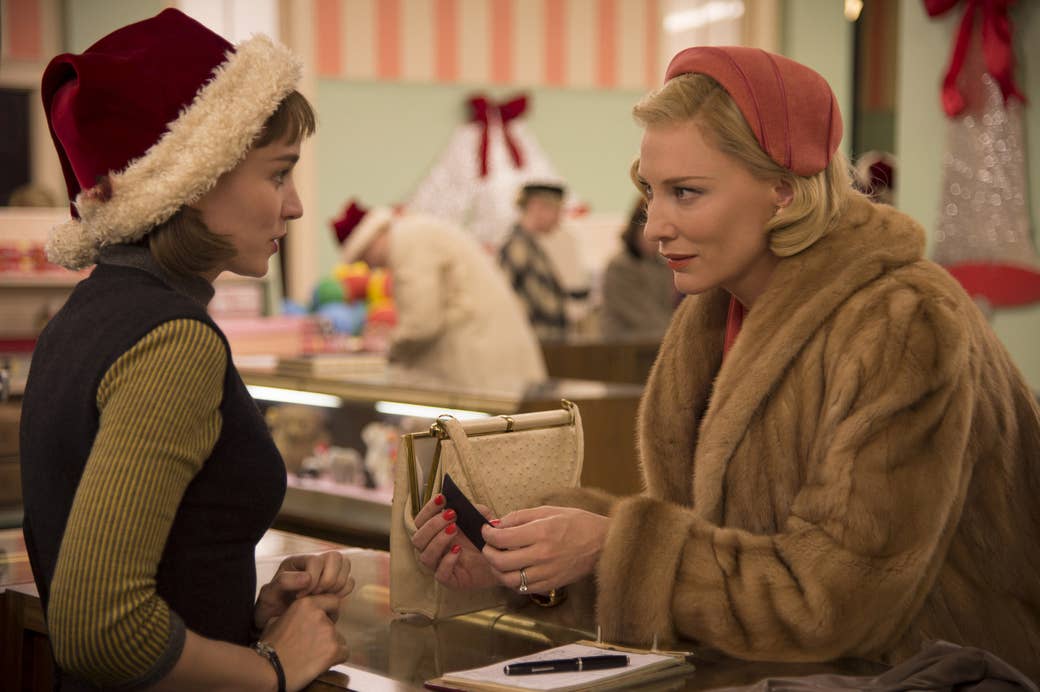
Carol was adapted from Patricia Highsmith’s novel The Price of Salt, a groundbreaking work for lesbian readers in the 1950s (and, for that matter, many lesbian readers since); by all accounts, the film would follow suit. The early reviews, starting with its gushed-over premiere at Cannes earlier this year, triumphantly announced that the best lesbian film ever made had finally arrived. For a demographic particularly starved for good, high-quality films, this was an exciting moment indeed. One of my colleagues referred fondly to Carol as “Lezzie Mad Men.”
On the Mad Men front, I agree with her wholeheartedly in terms of aesthetic vibe. The costuming, by Sandy Powell, is a total dream: We first see Carol looking devastatingly luxe in a caramel-colored mink coat, and she’s frequently bedecked in scarlet; the whole film is awash with reds. A rapturous score by Carter Burwell floods the film with feeling when otherwise thoughts go more or less unspoken. Judy Becker’s production design, too, is slinky and sultry, a divine scenescape of 1950s New York at Christmastime; it’s rich without quite being warm. In fact, that’s how I’d describe the film at large.
Carol is gorgeous — a marvel, even. But it’s so masterfully orchestrated that the emotional takeaway, to me, is overall more style than substance. Much of the communication between Carol and Therese occurs just under the surface, which could be construed as provocative and intimate. Cate Blanchett is a veritable master of the gaze: In one scene, the women are interrupted at a restaurant during a particularly high-stakes conversation, and the look that Carol gives Therese absolutely overflows with regret, and devastation, and longing. This just-under-the-surface emotional tactic works particularly well in the early stages of a courtship, when it’s enough for two pairs of eyes to meet across a crowded department store. Once these women actually fall in love, though, I personally would rather that love be verbalized, made explicit. Carol’s tremulous “I love you,” near the film’s end, is all the more shocking because of its expressive rarity. For the most part, Todd Haynes keeps us at a respectable distance — one worthy of a gorgeous upper-class ex-housewife with a secret.
Of course, on the streets of New York in the 1950s, lesbians did have to take the proper precautions. In that sense, the film relying so much on looks and gestures smartly reflects a time period wherein queer people found one another using physical signals, rather than dating apps. But alone in their many hotel rooms across the Midwest, Carol and Therese have the opportunity to lay themselves bare — and those scenes don’t carry nearly as much emotional weight as the ones in which either is battling with external elements, whether that's Carol's husband or the public's prying eyes. Even moments when they’re alone in Carol’s car are more moody and visual than personal and revelatory.
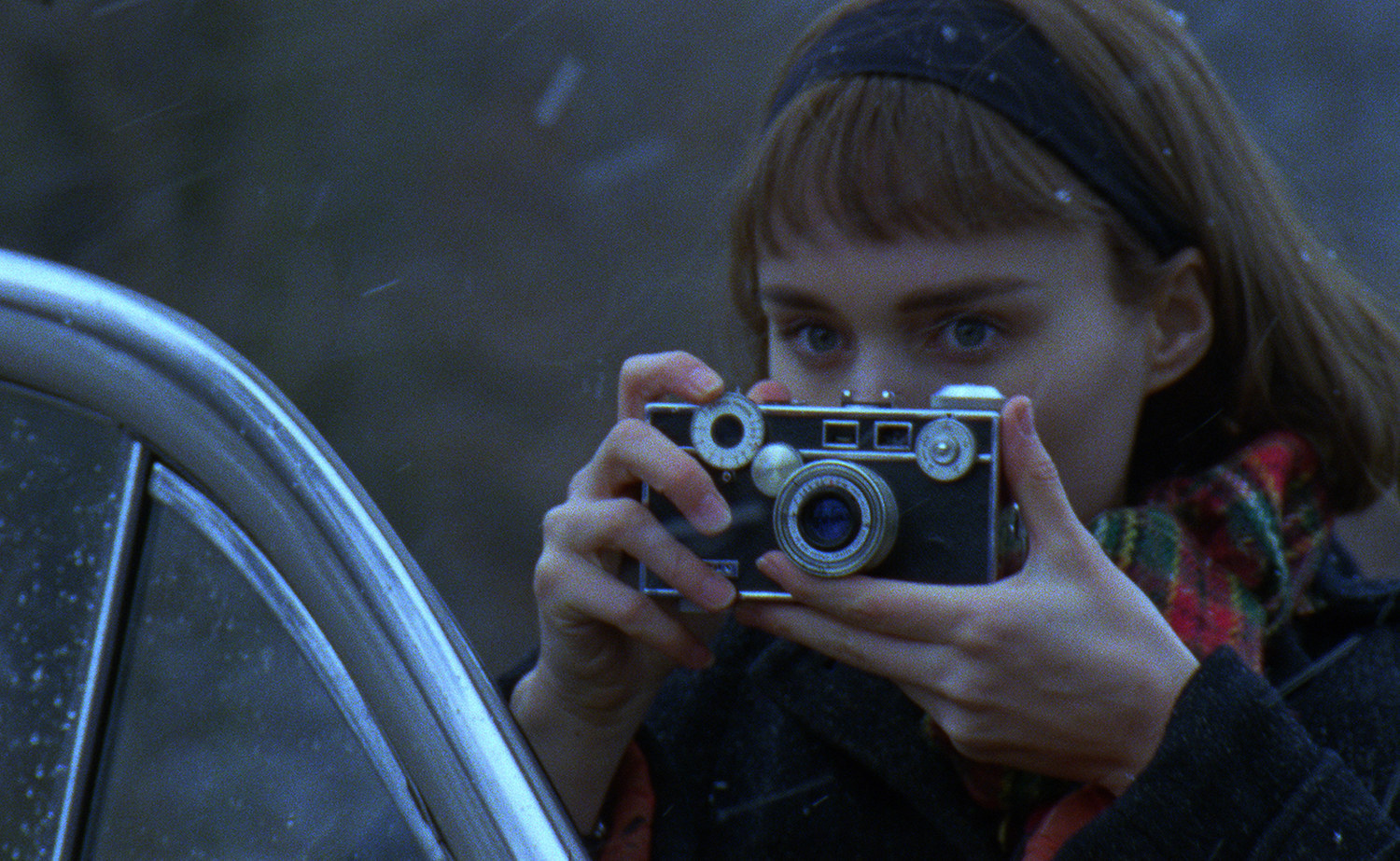
These women found each other while both adrift: Therese, plugging along in a relationship with a guy she wasn’t all that into, itching to throw herself into a more exciting and artistic career; Carol, in the midst of a messy divorce, her husband aware of her past affair with a woman (Sarah Paulson) and threatening to deny her custody of their daughter on “moral” grounds. Carol and Therese seem to find connection in spite of themselves, thrust out of undesirable life circumstances and into each other’s arms. While I have no trouble believing their physical pull to each other, a harder sell is why they’d match emotionally beyond mere incidentals. I could see why someone might fall in love with Carol, even if that love was powered by Blanchett’s performance alone: She’s glamorous, assertive, sexy, the one who cracks a handful of quiet jokes. Therese, on the other hand, is a relatively empty vessel into which the reserved Mara pours little.
At times, these characters seemed more to me like symbolic stand-ins for women, rather than people with intense and complementary inner lives. While there’s plenty to be gleaned from glances, I’d rather see a relationship built on a little bit more than what simply goes unsaid.
A similar sort of interplay defines Clouds of Sils Maria, an Olivier Assayas film and Cannes standout from 2014. There’s plenty of talking when the two main characters — Juliette Binoche as aging actress Maria and Kristen Stewart as her younger assistant, Val — rehearse lines for one of Maria’s upcoming plays, but the way both of these women actually feel toward each other is buried deep beneath the scripts in front of them. Maria and Val are acting out the parts of a lesbian relationship, and the sexual tension simmers steadily to their lived surface. Spoiler alert — Maria and Val don’t actually get together, but instead get steeped in layer upon layer of symbolism: Maria the Older Woman who’s terrified of getting replaced by an ingenue, and Val the Younger who’s intrigued by Maria, but ultimately not to the extent that she’d sleep with her. They’re foils of each other, womanhood through the looking glass. I once called this particular queerbaiting technique "highbrow no homo."
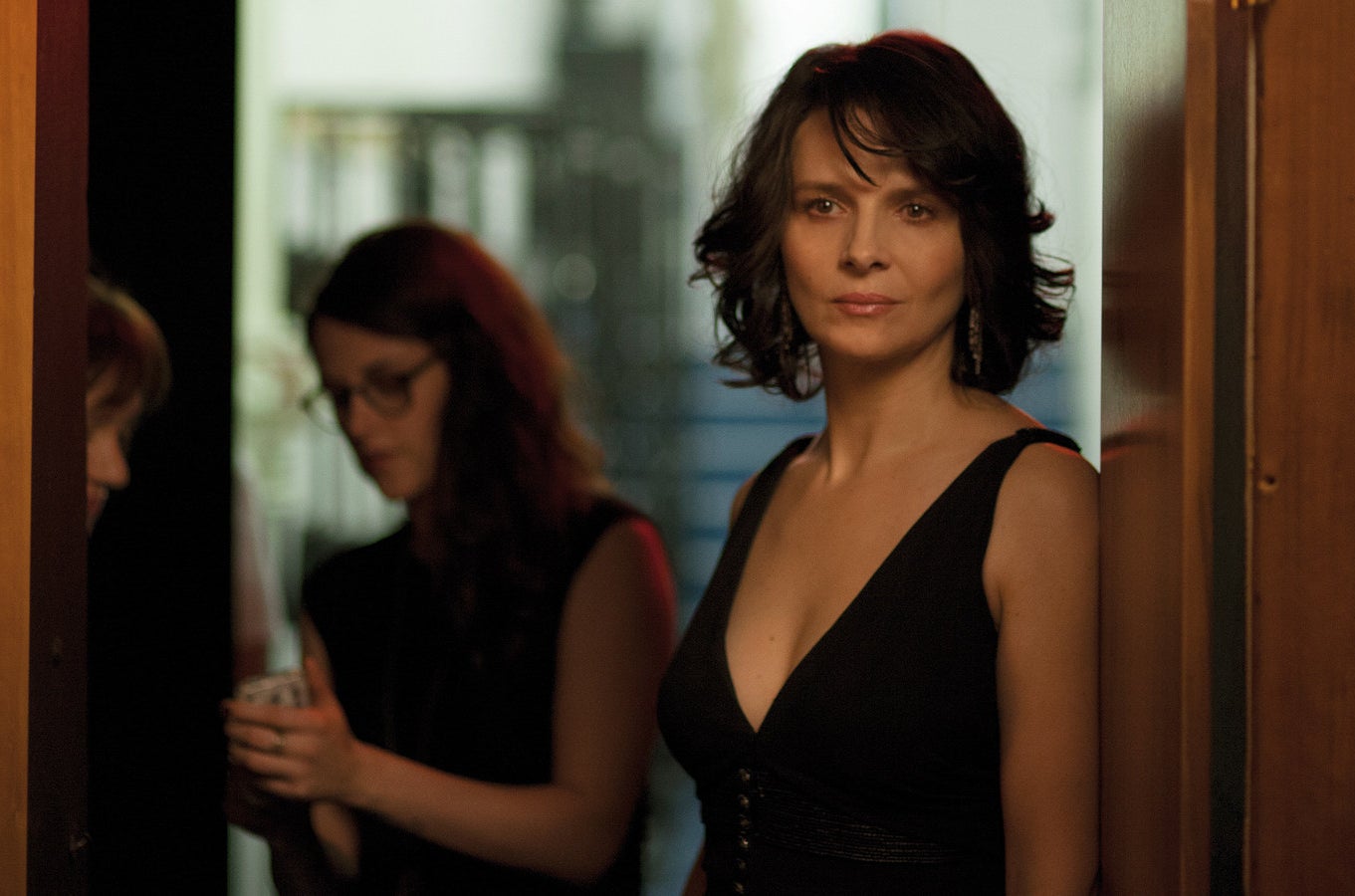
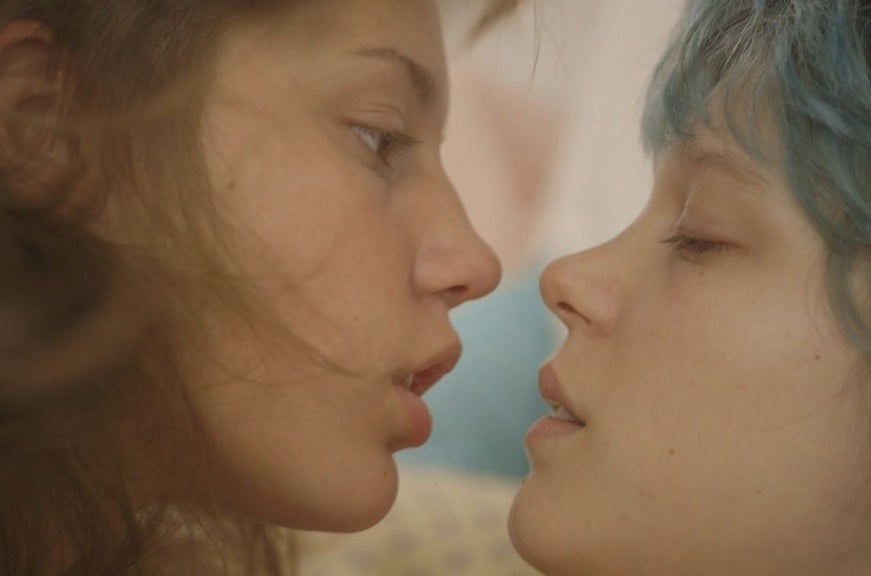
Of course, in Carol, the women do actually get together, and that is something to celebrate. What’s more — and this is major — Carol has a (relatively) happy ending. Key word: relatively. In the end, this is still a story about queer oppression in the 50s, and Carol in particular does have to give up something major. But nobody dies! For a queer film, that’s a pretty big deal. We’ve all grown too used to queer hardship and devastation being refashioned as cheap Oscar bait, a tradition that’s hopefully on the outs. Should Carol be critically and commercially successful — and it certainly looks to be headed in that direction, with a 95% score on Rotten Tomatoes as of this writing — it will signal to a world frustratingly slow on the uptake that queer storylines devoid of tragedy can still resonate, and producers should really start funding more of them.
I can’t help, though, but feel a slight similarity in the way both Carol and Clouds of Sils Maria treat their characters by allowing tremendous performances (Binoche and Stewart were both killer) alongside other cinematic strengths like camerawork and set design to make the women so ethereal, so representative of something bigger than themselves, as to make them more or less untouchable. So, too, is that the case with Blue Is the Warmest Color, the 2012 French film by the ethically questionable director Abdellatif Kechiche, with its infamous seven-minute lesbian sex scene. After the lead actresses contended they’d been horribly mistreated on set, it’s hard to watch the film without their revelations in mind — especially because their naked bodies are so often graphically matched with marble statues, their characters more symbols of museworthy beauty than they are just plain old ordinary women in love with each other.
Though Carol treats its women characters far more gracefully than Blue does, the fundamental love story between Carol and Therese still feels, on the whole, more feminine-figurative than practical. I want to believe that Therese and Carol would love each other beyond mere circumstance, long after the dust settles from their Midwestern getaway in Carol’s glossy Packard. Even though the film affords us the thrilling possibility of happiness for these women, it’s difficult for me to imagine what their happiness would actually look like in the gritty rhythms of day-to-day life, when they’re no longer running anymore. We simply have to believe in them. I'm not sure if that's enough.
